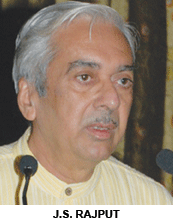 On September 5, India will once again formally celebrate Teacher’s Day. “No people rise above the level of their teachers” is an oft-repeated aphorism quoted during most official deliberations on education and related issues. Every year on Teacher’s Day, it’s mandatory to shower praises on the teachers’ community. But having spent five decades in the profession, it’s impossible to close one’s eyes to the reality of the situation as it exists in the country’s classrooms.
On September 5, India will once again formally celebrate Teacher’s Day. “No people rise above the level of their teachers” is an oft-repeated aphorism quoted during most official deliberations on education and related issues. Every year on Teacher’s Day, it’s mandatory to shower praises on the teachers’ community. But having spent five decades in the profession, it’s impossible to close one’s eyes to the reality of the situation as it exists in the country’s classrooms.
Regular surveys indicate that quality of education is of little consequence in the routine functioning of schools, colleges and universities of India. Governments measure progress merely in terms of numbers. More schools, more colleges, higher enrolments, and larger allocations are believed to indicate progress! Abolition of examinations prior to class VIII evokes applause for the HRD minister. Optional annual examination at the end of class X elicits appreciation from parents and educationists. How uplifting it is to read that the Right to Free and Compulsory Education (RTE) Act became law on April 1 last year, and that universalisation of secondary education is just round the corner!
Yet the question must be posed and answered satisfact-orily: Is India really “bringing out the best of body, mind and spirit” from its children thro-ugh its educational policies and implementation strategies? Even cursory scrutiny of teacher preparation and orientation systems will indicate why India is losing considerably on quality.
First, the great majority of teacher training and prepa-ration institutions have regrettably, been converted into money-generating ventures. Second, several state governments have discovered a way of countering the much-publicised resources-crunch by appointing untrained and inadequately equipped para teachers under different nomenclatures, paying a pittance by way of honoraria. Financial insecurity coupled with the task of conducting single-teacher schools kills the enthusiasm of teachers from day one. Add to that the stress caused by rampant corruption in appointments, transfers and promotions.
The ability to learn lifelong is the first requirement of the 21st century for the survival of every individual aspiring to remain a contributing entity. This requirement immediately projects the image of a learning society which offers various opportunities to learners of all ages, not only within formal institutions but also through informal, open and distance learning systems. Institutional networking and close collaboration between schools, business and industry, and communities also becomes necessary and no teacher can remain effective if she is unaware of the changes occurring at a fast pace in the various spheres of social, cultural and economic life. Therefore contemporary teacher effectiveness is now a function of complex parameters including technical and professional development combined with human factors, cultural appreciation, political acumen and willingness to learn continuously.
Moreover, teacher effectiveness also has to move from individual excellence to group development. While eminent teacher educators and scholars routinely plead for teaching to be given the recognition of a profession, teachers have not succeeded in internalising the idea of emerging as competent and respected professionals within society. Most important, this spirit is wholly absent in the majority of teacher training institutions across the country. Meanwhile, the number of these dispirited institutions has multiplied from less than 2,600 in the year 2000 to over 14,000 in 2008!
A profession acquires its strength, credibility and social acceptability on the basis of the competence, commitment and performance of its practitioners. Its social esteem can’t survive merely on past practices and historical reputation. The much-highlighted relationship of mutual respect and devotion between society and teachers has worn too thin at this stage of history. It has declined in inverse proportion to the growing trend of tuitions, coaching classes and resulting lack of interest in formal teaching in schools, particularly those maintained and financed by government.
Policy makers often ignore these critical aspects as ‘matters of detail’ to be rectified at the school or teacher levels. This is a major fault-line in education planning in India. The path to comprehensive progress and development of the nation runs through the gates of the country’s primary schools located in the rural, hilly and tribal hinterlands. And these gates will send out well-equipped citizens only if teachers fit to be called teachers are available. So long as these realities remain neglected, only a small well-educated minority will continue to amass resources at the cost of the majority. The dream of equality of access and success guaranteed to every child will remain elusive despite the RTE Act and other such measures.
The youth of India have established their cognitive superiority globally. And this is the situation when only about 25 percent of children acquire education of acceptable quality in our schools. Imagine the measure and volume of India’s cognitive capital if all primary-secondary schools become functional under the tutelage of teachers who command respect in the traditional Indian way.
(Prof. J.S. Rajput is former chairperson, National Council for Teacher Education and former director of NCERT)